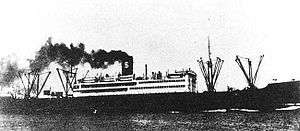SS Kachidoki Maru
SS Kachidoki Maru was a former US passenger ship, built in 1920 and captured by the Japanese in 1941, which was torpedoed on 12 September 1944, carrying 950 Allied POWs of which 431 were killed.
 Kachidoki Maru | |
| History | |
|---|---|
| Name: | Wolverine State |
| Builder: | New York Shipbuilding Corporation (New Jersey) |
| Launched: | 1920 |
| In service: | 1920-1941 |
| Fate: | Beached on Shaweishan Island and captured by Japan |
| History | |
| Name: | Kachidoki Maru |
| In service: | 1941-1944 |
| Out of service: | 12 September 1944 |
| Fate: | Sunk, 12 September 1944 |
| General characteristics | |
| Type: | Troop transport |
| Tonnage: | 10,509 tons[1] |
| Length: | 153 m |
| Beam: | 19 m |
| Draught: | 8.6 m |
| Speed: | 14 knots |
Construction : SS Wolverine State
Kachidoki Maru was built in 1920 as Wolverine State, one of seven Design 1095 ships, by the United States Shipping Board at New York Shipbuilding Corporation, Camden, New Jersey. Renamed President Harrison in 1922, she was operated by Swayne & Hoyt Lines on a service connecting the United States West Coast to Brazil and Argentina with the Pacific-Argentine-Brazil Line. In 1923, the ship was transferred to the Dollar Steamship Lines and sailed on their round-the-world passenger service until 1938. Chartered by the United States Army in December 1941 to evacuate 4th Marines from Shanghai, she was beached on the return trip for additional evacuation, but salvaged and repaired by the Japanese, which renamed her Kakko Maru and later Kachidoki Maru.[2]
Service history
The troopship was part of convoy HI-72, transporting some 950 Australian and British prisoners of war (POWs) and 1,095 Japanese from Singapore to Formosa (Taiwan). Another ship in the convoy was SS Rakuyō Maru with 1,317 Allied POWs on board.[2]
On the morning of 12 September 1944, the convoy was attacked in the Luzon Strait by a wolfpack consisting of three US submarines: Growler, Pampanito and Sealion. Rakuyo Maru was torpedoed by Sealion and sunk with 1,159 POWs killed.
Kachidoki Maru was torpedoed and sunk by Pampanito. Japanese destroyers rescued most Japanese and 520 British prisoners from the Kachidoki. 431 prisoners of war, 45 troops and 12 crewmen were killed. The survivors were transferred to Kibutsu Maru and taken to Japan.[3]
References
- "Kachidoku Maru (+1944)". Wrecksite. Retrieved 2016-10-22.
- "KACHIDOKI MARU Tabular Record of Movement". Combinedfleet.com. Retrieved 2016-10-22.
- "Japanese Escorts". Combinedfleet.com. Retrieved 2016-10-22.